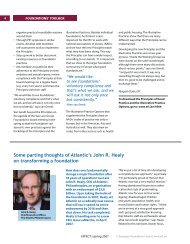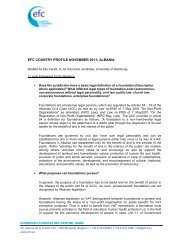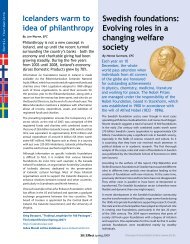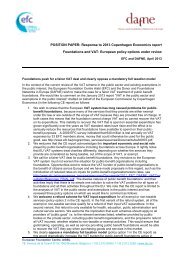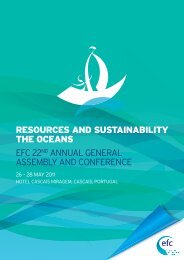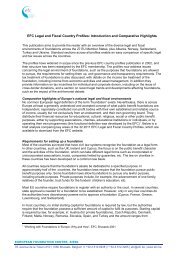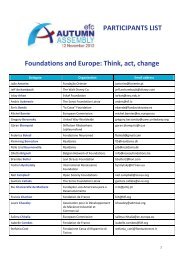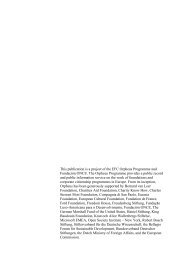European perspectives on global health: a policy glossary
European perspectives on global health: a policy glossary
European perspectives on global health: a policy glossary
You also want an ePaper? Increase the reach of your titles
YUMPU automatically turns print PDFs into web optimized ePapers that Google loves.
3. Europe must assert its role in <strong>global</strong> <strong>health</strong> governance<br />
Financing for <strong>global</strong> <strong>health</strong><br />
The resource streams for <strong>global</strong> <strong>health</strong> are<br />
difficult to calculate as they come from a wide<br />
array of sources. Dominant in the <strong>global</strong> <strong>health</strong><br />
discussi<strong>on</strong> is financing through foreign aid<br />
but other sources of finance have increased<br />
significantly. Of increasing importance is<br />
<strong>global</strong> public goods financing. Europe needs to<br />
explore new financing mechanisms to ensure<br />
the three strategic priorities of <strong>global</strong> <strong>health</strong> :<br />
security, equity and good governance.<br />
The discussi<strong>on</strong> of financing for <strong>global</strong> <strong>health</strong> is usually<br />
dominated by a debate <strong>on</strong> funding for development<br />
and a call to d<strong>on</strong>or countries to increase their support<br />
of developing countries. Lately, an additi<strong>on</strong>al debate<br />
<strong>on</strong> financing <strong>global</strong> public goods – such as <strong>global</strong><br />
disease surveillance systems – has emerged, and<br />
the UNDP is suggesting a new approach to <strong>global</strong><br />
public finance. The neglected area of financing for<br />
<strong>global</strong> <strong>health</strong> is the financing of the regular budget of<br />
internati<strong>on</strong>al organisati<strong>on</strong>s – such as WHO. There is<br />
a tendency to fund diseases, issues and programmes<br />
– as discussed below – but not governance structures.<br />
This though has led to a significant weakening of a<br />
number of internati<strong>on</strong>al organisati<strong>on</strong>s. Europe should<br />
be at the forefr<strong>on</strong>t of exploring new financing and<br />
governance mechanisms that ensure all three strategic<br />
priorities of <strong>global</strong> <strong>health</strong> : security, equity and good<br />
governance.<br />
The most comprehensive study <strong>on</strong> resource needs for<br />
<strong>global</strong> <strong>health</strong> is still the report of the Commissi<strong>on</strong><br />
<strong>on</strong> Macroec<strong>on</strong>omics and Health ( CMH ),<br />
commissi<strong>on</strong>ed by WHO and directed by Jeffrey Sachs,<br />
while other estimates tend to focus <strong>on</strong> the resource<br />
needs for single issues or diseases.<br />
The CMH report starts with the observati<strong>on</strong> that<br />
“<strong>on</strong>ly a handful of diseases and c<strong>on</strong>diti<strong>on</strong>s are<br />
resp<strong>on</strong>sible for most of the world’s <strong>health</strong> deficit :<br />
HIV / AIDS ; malaria ; TB ; diseases that kill mothers<br />
and their infants ; tobacco-related illness ; and<br />
childhood diseases”. In order to improve <strong>health</strong> in<br />
the developing world additi<strong>on</strong>al financing especially<br />
in three areas is required : scaling-up of existing<br />
interventi<strong>on</strong>s, R&D, and <strong>global</strong> public goods. The report<br />
states that effective interventi<strong>on</strong>s exist to prevent<br />
Global Health Policy Glossary<br />
or cure most of the above-menti<strong>on</strong>ed diseases.<br />
Both nati<strong>on</strong>al and internati<strong>on</strong>al spending, however,<br />
are insufficient to meet the challenges. While total<br />
spending <strong>on</strong> <strong>health</strong> per pers<strong>on</strong> / year amounts to<br />
nearly $2000 in the developed world, it is <strong>on</strong>ly $11 in<br />
the least developed countries ( with $6 being public<br />
domestic spending, $2.3 being d<strong>on</strong>or assistance and<br />
the rest being out-of-pocket expenditures ). In order<br />
to scale up the existing interventi<strong>on</strong>s and to prevent<br />
8 of the 16 milli<strong>on</strong> deaths per year from the above<br />
menti<strong>on</strong>ed diseases, $34 per pers<strong>on</strong> / year would be<br />
necessary. The CMH report thus recommends that the<br />
developing countries should increase their budgetary<br />
spending <strong>on</strong> <strong>health</strong> by an additi<strong>on</strong>al 1 % of GNP by<br />
2007 and 2 % by 2015, while d<strong>on</strong>or countries should<br />
help to close the gap by increasing from the current<br />
levels of <strong>health</strong>-related ODA of approximately $6<br />
billi<strong>on</strong> per year to $27 billi<strong>on</strong> by 2007 and $38 billi<strong>on</strong><br />
by 2015.<br />
More recent studies do not focus exclusively <strong>on</strong><br />
<strong>health</strong>, but deal with the resource needs for the<br />
entire process of the Millennium Development Goals<br />
( MDGs ). The study of the “High-Level Panel <strong>on</strong><br />
Financing for Development” that served as<br />
input for the “Internati<strong>on</strong>al C<strong>on</strong>ference <strong>on</strong> Financing<br />
for Development” in M<strong>on</strong>terrey 2002 was the first<br />
to specify the amount of ODA that is required to<br />
meet the MDGs and gives the often cited figure of<br />
$50 billi<strong>on</strong> / year, supplemented by $3 billi<strong>on</strong> / year<br />
for humanitarian aid and $15 billi<strong>on</strong> / year for the<br />
provisi<strong>on</strong> of <strong>global</strong> public goods, leading to a total<br />
of $68 billi<strong>on</strong> / year or a doubling of the current<br />
levels of aid. Other studies basically c<strong>on</strong>firm these<br />
quantities, while NGOs like Oxfam ( 2002 ) assume a<br />
<strong>global</strong> need of around $100 billi<strong>on</strong> / year. The report<br />
of the Millennium Project ( 2005 ) estimates the<br />
resource needs to be even higher and states that in<br />
order to achieve the MDGs, ODA of $135 billi<strong>on</strong> / year<br />
( = 0,44 % of GNI ) will be needed in 2006 and<br />
that internati<strong>on</strong>al funding will have to rise to $195<br />
billi<strong>on</strong> / year ( = 0,54 % of GNI ) by 2015.<br />
This logically leads to the questi<strong>on</strong> of where the<br />
additi<strong>on</strong>al m<strong>on</strong>ey should come from. The report of the<br />
Millennium Project does not say much in that c<strong>on</strong>text ;<br />
it <strong>on</strong>ly vaguely menti<strong>on</strong>s the opti<strong>on</strong> to “fr<strong>on</strong>tload”<br />
ODA through capital markets via the Internati<strong>on</strong>al<br />
Finance Facility ( IFF ), as proposed by Gord<strong>on</strong> Brown,<br />
the UK Chancellor. Other studies go further <strong>on</strong> these<br />
41



